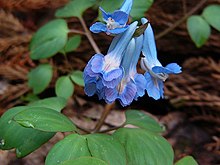Corydalis ambigua
| Corydalis ambigua | |
|---|---|

| |
| Scientific classification | |
| Kingdom: | Plantae |
| Clade: | Tracheophytes |
| Clade: | Angiosperms |
| Clade: | Eudicots |
| Order: | Ranunculales |
| Family: | Papaveraceae |
| Genus: | Corydalis |
| Species: | C. ambigua
|
| Binomial name | |
| Corydalis ambigua | |
Corydalis ambigua is a tuberous early flowering east Asian flowering plant species in the poppy family Papaveraceae. Its exact native range is obscure due to taxonomic confusion.[1] It is one of the sources of the drug tetrahydropalmatine.
Chemistry[]

Corydalis ambigua contains a variety of alkaloids including corynoline, acetylcorynoline d-corydalin, dl-tetrahydropalmatine, protopine, tetrahydrocoptisine, dl-tetrahydrocoptisine, and allocryptopine.[2][3][4][5]
Chemical derivatives of tetrahydroprotoberberines present in Corydalis ambigua have been studied as potential ways to increase pain tolerance and for treating drug addiction.[6] Further, they may represent a category of neurotransmitter stabilizers which have potential use in broad range of psychotic and neurological disorders.[6]
Use[]
Cordyalis ambigua is part of the traditional Ainu cuisine:
The bulbs of this plant are extensively eaten by the Ainu, especially by those in the Ishikari valley, Saghalien, and Southern Kuriles. The bulb has a slightly bitter taste, which is removed by repeated boilings in water. In Etorup, the Ainu boil with a certain kind of earth to remove its bitterness. They are eaten either simply boiled or mixed with rice. In Saghalien, it is said that they are cooked generally with the fat of seals. The bulbs are often boiled and then dried for future use.[7]
See also[]
- Chinese herbology
References[]
- ^ a b "Corydalis ambigua". Germplasm Resources Information Network (GRIN). Agricultural Research Service (ARS), United States Department of Agriculture (USDA). Retrieved 2008-02-04.
- ^ Zhu, Da-Yuan; et al. (1981). "IDENTIFICATION OF THE STRUCTURES OF CORYDALIS F, I, J AND K". Acta Chimica Sinica.
- ^ Ma, W.g.; Fukushi, Y.; Tahara, S. (1999). "Fungitoxic alkaloids from Hokkaido Corydalis species". Fitoterapia. 70 (3): 258–265. doi:10.1016/S0367-326X(99)00045-3.
- ^ Hiraoka, Noboru; et al. (2004). "Alkaloid production by somatic embryo cultures of Corydalis ambigua". Plant Biotechnology. 21 (5): 361–366. doi:10.5511/plantbiotechnology.21.361.
- ^ Zhu, Xing-Zu (1991). "Memórias do Instituto Oswaldo Cruz - Development of natural products as drugs acting on central nervous system". Memórias do Instituto Oswaldo Cruz. 86: 173. doi:10.1590/S0074-02761991000600039. PMID 1841995.
- ^ a b Zhen X.-C. (2010). "Tetrahydroprotoberberines (THPBs) in neuropsychological disorders: Recent development and prospective (Abstract S-33.004)". International Journal of Neuropsychopharmacology. 13 (SUPPL. 1): 41.
- ^ Batchelor, John; Miyabe, Kingo (1893). "Ainu economic plants". Transactions of the Asiatic Society of Japan. XXI: 215.
Further reading[]
- Bhakuni, D. S.; Chaturvedi, Rekha (1983). "The Alkaloids of Corydalis meifolia". Journal of Natural Products. 46 (4): 466–70. doi:10.1021/np50028a006. PMID 6631434.
- Corydalis
- Medicinal plants of Asia
- Medicinal plant stubs
- Ranunculales stubs